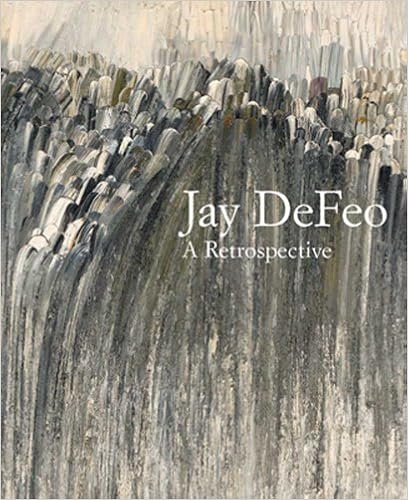
Mary Joan Jay DeFeo (March 31, 1929 – November 11, 1989) was a visual artist associated with the Beat generation who worked c.1950–89 in the San Francisco Bay Area
In 1951, a fellowship provided her the opportunity to travel widely in Europe where she worked feverishly. During a three-month period in Florence, she completed more than two hundred paintings.] She studied African and prehistoric art in Paris and London libraries. After her brief time working in Paris and London, she traveled in Europe and North Africa, and for six months worked in Florence, where she started to find her own kind of imagery.
Upon returning to Berkeley, she rented an apartment and took odd jobs. She continued her exploration with image and materials. In 1953, she was fired from her job teaching art to children at the California College of the Arts and Crafts after being convicted for shoplifting two cans of paint. In the mid-1950s, she supported herself by making and selling jewelry. It was during this period, she met Wally Hedrick, a student at the California College of Arts and Crafts and a proponent of what was described as "personalized Dada". They married in 1954 and shared a building on Fillmore Street which was a hang out for other artists, writers and jazz musicians. The artist Billy Al Bengston remembers DeFeo as having "style, moxie, natural beauty and more ‘balls’ than anyone."
Hedrick, Deborah Remington, Hayward King, David Simpson, John Allen Ryan and Jack Spicer founded the Six Gallery at 3119 Fillmore St in San Francisco, on the location of the King Ubu Gallery, which had been run by Jess and Robert Duncan. Joan Brown, Manuel Neri, and Bruce Conner would become associates of the Six Gallery. DeFeo was present when Allen Ginsberg first read his poem Howl at the famous Six Gallery reading in 1955. In 1959, DeFeo became an original member of Bruce Conner's Rat Bastard Protective Association
In 1959, DeFeo was included in Dorothy Canning Miller's seminal exhibition Sixteen Americans at the Museum of Modern Art, alongside Jasper Johns, Ellsworth Kelly, Robert Rauschenberg, Frank Stella, and Louise Nevelson. Following this she had a solo exhibition at the Ferus Gallery in Los Angeles.
Throughout her four decades of making art, DeFeo worked extensively making drawings, paintings on paper, photographs, photocopies, collages, photo collages and paintings. DeFeo took a position teaching at the San Francisco Art Institute, and in 1970, she began creating photographs and paintings of her own dental bridge, which a gum disease had necessitated. DeFeo went on to work in several mediums, including intricately detailed drawings. In 1980, she became a professor on the faculty of Mills College. In 1987, DeFeo traveled to Africa, inspiring her to produce a series of abstract drawings called “Reflections of Africa.”
Jay DeFeo (1929–1989) was part of a vibrant community of avant-garde artists, poets, and musicians in San Francisco during the 1950s and 1960s. Her circle included Wallace Berman, Joan Brown, Bruce Conner, Wally Hedrick, Edward Kienholz, and Michael McClure. Although best known for her monumental painting The Rose (1958–66), DeFeo worked in a wide range of media and produced an astoundingly diverse and compelling body of work over four decades. DeFeo's unconventional approach to materials and her intensive, physical method make her a unique figure in postwar American art.
In, this, the first comprehensive monograph on DeFeo, Dana Miller looks at the breadth of the artist's work, her cross-disciplinary practice, broad range of interests and influences, as well as pivotal moments in her career. In addition, Miller dispels misconceptions and assumptions about the artist and also offers new insight into her under-recognized works from the 1970s and 1980s. Greil Marcus explores the significance of titles in DeFeo's work; Michael Duncan considers her approach to her career and the marketplace; Corey Keller looks at DeFeo's photographic oeuvre; and Carol Mancusi-Ungaro examines her materials and processes.
The book features new photography, archival images, and a number of previously unpublished works. Also included are a biographical chronology, an extensive bibliography, and an exhibition history.
No comments:
Post a Comment